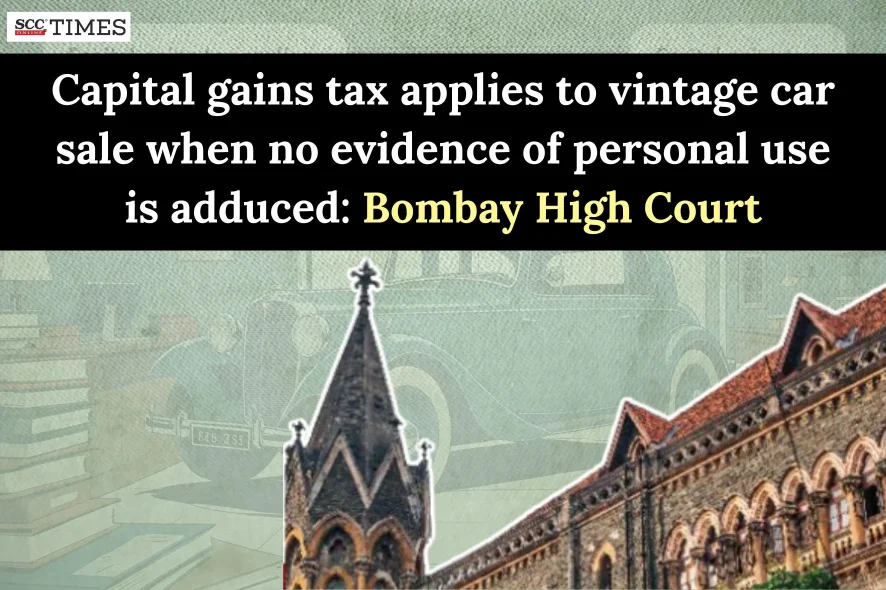Bombay High Court: The present appeal was filed by the Assessee challenging the Income Tax Appellate Tribunal’s (‘ITAT’) decision treating profit from the sale of a vintage car as taxable capital gains rather than exempt as a “personal effect”. The Assessee argued that the car was his personal asset and should not attract capital gains tax. The Division Bench of Alok Aradhe, CJ*., and Sandeep V. Marne, J., held that for an article to qualify as a “personal effect”, there must be evidence of personal use. Since, the Assessee failed to adduce any evidence with regard to the vintage car being put to personal use, therefore, the Court upheld ITAT’s order and rule that pride of possession did not constitute personal use under Section 2(14) of the Income Tax Act, 1961 (‘1961 Act’).
Background:
The Assessee was a salaried employee of Indu Nishan Oxo-Chemical Industries Ltd. with income from house property, share income, dividend, etc. He filed his return of income on 28-11-1992 for Assessment Year 1992—1993 declaring a total income of Rs 2,79,440. The Assessing Officer noticed that the Assessee had purchased a vintage car “Ford Tourer” 1931 Model in 1983 for Rs 20,000 and sold it for Rs 21 Lakh. The Assessee stated on 28-01-1994 that the car was shown as a personal asset in Wealth-tax and was exempt. On 08-03-1994, the Assessing Officer added Rs 20,80,000 as business income from the sale.
Consequently, the Assessee filed an Appeal. The Commissioner of Income Tax (Appeals) [‘CIT (A)’], by order dated 31-08-1994, held vintage cars were not used frequently due to high maintenance costs, the car was shown as personal asset in Wealth-tax returns, no depreciation was claimed, and spare parts were locally fabricated. The CIT(A), therefore set aside the addition of Rs 20,80,000 under ‘profits from sale of car’. Accordingly, the Appeal was partly allowed.
Aggrieved by the order passed by the CIT(A), the Revenue filed an appeal before the ITAT. The ITAT reversed the CIT(A)’s findings and held that the car was not used as a personal effect, set aside the CIT(A)’s order, allowed the Revenue’s appeal, and restored the Assessing Officer’s decision, resulting in the present appeal.
The Assessee alleged that the ITAT was not justified in holding the car was not a personal asset and that the gain was taxable under ‘capital gain’. It was submitted that the ITAT did not dispute basic facts, including the department’s acceptance of the car as a personal asset and maintenance expenses debited to the capital account. The finding that no evidence was adduced was termed perverse by the Assessee. The counsel for Revenue supported ITAT’s order and submitted that its finding did not suffer from any infirmity warranting interference by this Court under Section 260-A of the 1961 Act.
Analysis and Decision:
The Court while examining Section 2(14) of the 1961 Act observed that the capital assets did not include personal effects, that was to say movable property including wearing apparel and furniture but excluding jewellery held for personal use by the Assesses or any other member of his family dependent on him. The Court further noted that the personal effects must be for personal use for being excluded from the definition of the term ‘capital assets’.
The Court emphasised that, to treat a movable property as personal effects, an intimate connection between the effects and the person of the Assessee had to be shown. The Court highlighted that the phrase ‘intended for personal or household use’ did not mean capable of being intended for such use but rather meant normally or commonly intended for personal or household use. The Court further clarified that the capability of a car for personal use did not lead to automatic presumption that every car would be personal effects for being excluded from capital assets of the Assessee.
The Court observed that the Assessee had failed to adduce any evidence regarding the vintage car being put to personal use, and therefore the Tribunal had rightly reversed the order passed by the CIT(A) which had applied irrelevant considerations of wealth tax returns and non-claiming of depreciation. The Court further noted that the CIT(A) had failed to appreciate that these aspects were irrelevant for deciding personal use, while the ITAT had concentrated only on personal use, and it was not the case of the Assessee that the CIT(A)’s finding was perverse.
The Court emphasised that what needed to be proved was that the car was used as a personal asset by the Assessee. It was incumbent upon the Assessee to lead evidence showing actual personal use, which he admittedly failed to do. The Court pointed out several indicators that the car was never used personally: (i) Assessee used company’s car for commute, (ii) car was not used even occasionally, (iii) vintage car was not parked at Assessee’s residence, (iv) Assessee failed to prove any expenditure on maintenance, and (v) salaried employee purchased the car as pride of possession.
The Court, while dismissing the appeal, held that no attempt had been made to show that the ITAT’s finding, that the Assessee failed to produce evidence of personal use of the car was perverse since the failure to produce such evidence was an admitted fact. The Court found no reason to interfere with the ITAT’s order.
Consequently, the substantial question of law was answered in the negative and against the Assessee, and the Interim Application was also disposed of.
[Narendra I. Bhuva v. Assistant Commissioner of Income Tax, 2025 SCC OnLine Bom 2936, decided on 14-08-2025]
*Judgment authored by: Chief Justice Alok Aradhe
Advocates who appeared in this case:
For the Assessee: Vipul Joshi Mr. Prashant Ghumare i/b Namrata S. Kasale
For the Respondent: Prakash C. Chhotaray with Sangita Choure



